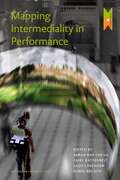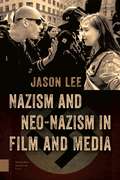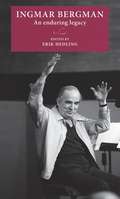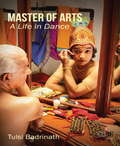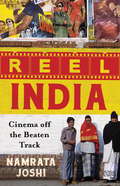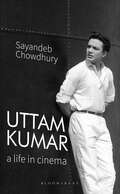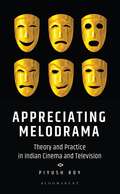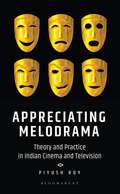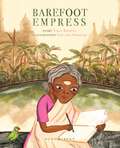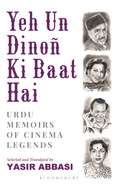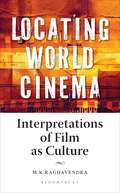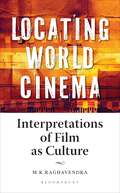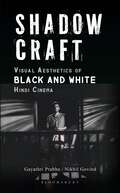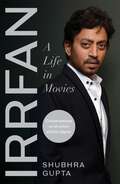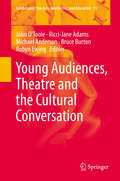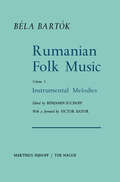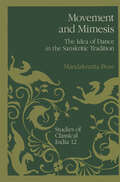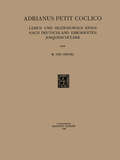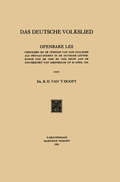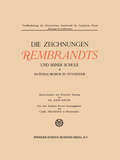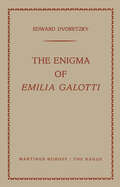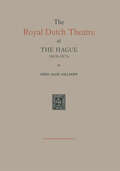- Table View
- List View
Mapping Intermediality in Performance (Mediamatters)
by Sarah Bay-Cheng Chiel Kattenbelt Andy Lavender Robin NelsonThis volume examines afresh the impact upon acting and performance of digital technologies. It is concerned with how digital culture combines the traditional ‘liveness’ of theatre with media interfaces and internet protocols. The time and space of the ‘here and now’ are both challenged and adapted, just as barriers between theatre-makers and the ‘experiencers’ of events are broken down. Today many of us are everyday players performing the interconnectedness of digital culture and a key aim of the book is to unpack the multiple interrelations within the landscape of contemporary performance. Access to a range of ‘instances’ (The Builders Association, Castellucci, Castorf, Gob Squad, Lepage, Second Life and VJing) is through ‘portals’ which afford perspectives on the main characteristics of theatre and performance in the digital age.
Nazism and Neo-Nazism in Film and Media (PDF)
by Jason LeeThis timely book takes an original transnational approach to the theme of Nazism and neo-Nazism in film, media, and popular culture, with examples drawn from mainland Europe, the UK, North and Latin America, Asia, and beyond. This approach fits with the established dominance of global multimedia formats, and will be useful for students, scholars, and researchers in all forms of film and media. Along with the essential need to examine current trends in Nazism and neo-Nazism in contemporary media globally, what makes this book even more necessary is that it engages with debates that go to the very heart of our understanding of knowledge: history, memory, meaning, and truth.
Ingmar Bergman: An enduring legacy (Lund University Press)
by Erik HedlingThis unique collection focuses on the work of legendary Swedish filmmaker Ingmar Bergman. Written in the wake of the centenary of Bergman’s birth in 2018, the volume aims to combine new approaches to Bergman’s films and writings with more traditional analyses. Established themes such as Bergman’s interest in philosophy and psychology are addressed, but also less familiar topics, notably his relationship with Hollywood and his elaborate use of film music and autobiographical writing that characterised his later work. There are new analyses of aspects of Bergman’s most famous films, including Smiles of a Summer Night and Fanny and Alexander, but also insightful readings of lesser-known works, such as Saraband and Sawdust and Tinsel.
Ingmar Bergman: An enduring legacy (Lund University Press)
by Erik HedlingThis unique collection focuses on the work of legendary Swedish filmmaker Ingmar Bergman. Written in the wake of the centenary of Bergman’s birth in 2018, the volume aims to combine new approaches to Bergman’s films and writings with more traditional analyses. Established themes such as Bergman’s interest in philosophy and psychology are addressed, but also less familiar topics, notably his relationship with Hollywood and his elaborate use of film music and autobiographical writing that characterised his later work. There are new analyses of aspects of Bergman’s most famous films, including Smiles of a Summer Night and Fanny and Alexander, but also insightful readings of lesser-known works, such as Saraband and Sawdust and Tinsel.
Master of Arts: A Life in Dance
by Tulsi BadrinathV.P. Dhananjayan was one of the first men to make a successful career as a Bharata Natyam dancer. In the late sixties, when he made this choice, Bharata Natyam – the classic dance form that Rukmini Devi helped evolve from the dance of the devadasis – was almost exclusively the domain of women. In making Bharata Natyam his profession, Dhananjayan had to create a space for his dance where none existed. It is only recently, in the relatively short span of the past seventy years, and to a great extent because of the creative efforts of versatile and innovative dancers like Dhananjayan, that greater number of men have performed Bharata Natyam as men, without needing to dress as women to appear on stage. As Dhananjayan’s student for nearly forty years now, and a trained dancer herself, the author, Tulsi Badrinath, chronicles the story of his brilliant life in dance with the insight of one who understands each nuance of it. Weaving her own life-long passion for Bharata Natyam with his remarkable story, she brings to light the difficulties faced by a male dancer in establishing himself in what was thought to be a somewhat unrespectable profession, and tells the compelling story of his life with empathy and understanding. Writing of his years in Kalakshetra and his departure from it; of the deep love that blossomed between him and his wife, Shanta, and the incredible dance partnership they forged, making them famous as The Dhananjayans; of his international collaborations with Ravi Shankar; and of his ability, as guru and teacher, to impart his passion for dance to his disciples, she explores her own understanding of what the dance, and her guru, have meant to her. Interspersing this remarkable tale of guru and shishya with the stories of other young male dancers in the realm of Bharata Natyam, she pays tribute to their extraordinary commitment, their talent and their courage.
Reel India: Cinema off the Beaten Track
by Namrata Joshi‘Picture abhi baaki hai…’ If there’s one experience that unites India, it is cinema. In Reel India, award-winning film critic Namrata Joshi journeys through the interiors of the country intimately chronicling little-known accounts about the nation’s incessant obsession with the movies. In Lucknow, she encounters a Shah Rukh Khan fan who has embraced an alternate reality in which he lives and breathes the star. In Wai, she finds an entire economy fuelled by the film industry as the town transforms into a film set. An activist filmmaker in Odisha demonstrates how he teaches local tribal people the basics of his craft, empowering them to train the spotlight on issues threatening their habitat and livelihood. From the fever pitch of the ‘first day first show’ in makeshift halls to the rivalries of regional cinema, this is India’s immersion in the movies like it’s never been seen before. Filled with real-life stories that are as fascinating as the revelations and insights they offer, Reel India raises the curtain on the starry-eyed dreams and big-screen passions that live on after the final ‘cut’ is announced.
Uttam Kumar: A Life in Cinema
by Sayandeb Chowdhury'There is none like Uttam and there will be no one to ever replace him. He was and he is unparalleled in Bengali, even Indian cinema.'-Satyajit Ray, Oscar-winning Indian film-makerActor and screen icon Uttam Kumar (1926–1980) is a talismanic figure in Bengali public life. Breaking away from established codes of onscreen performance, he came to anchor an entire industry and led the efforts to reimagine popular cinema in mid-20th-century Bengal. But there is pitifully less knowledge about Uttam Kumar in the learned circles-be it about his range of style and performance; the attractions and problems of his cinema; his roles as a producer and patriarch of the industry; or his persona, stardom and legacy.The first definitive cultural and critical biography of this larger-than-life figure engages meaningfully with his life and cinema, revealing the man, hero and actor from various, often competing, vantages. The conceptual aim is to locate a star figure within a larger historical and cultural context, and to enquire into how a towering image was mobilised for an ever-greater, wholesome, popular and even, at times, radical and progressive entertainment. A complimentary métier of this work is to explore why and how this star persona would go on to reconstitute the bhadrolok Bengali visual and cultural world in the post-Partition period.But above all, this is the story of a clerk who became an actor, an actor who became a star, a star who became an icon and an icon who became a legend.
Appreciating Melodrama: Theory and Practice in Indian Cinema and Television
by Piyush RoyAppreciating Melodrama: Theory and Practice in Indian Cinema and Television seeks to identify and appreciate the continual influence of the ancient Sanskrit drama treatise, the Natyashastra, and its theory of aesthetics, the rasa theory, on the unique narrative attributes of Indian cinema.This volume of work critically engages with a representative sample of landmark films from 100 years of Indian film history across genres, categories, regions and languages. This is the first time a case study-based rigorous academic review of popular Indian cinema is done using the Indian aesthetic appreciation theory of rasa (affect/emotion). It proposes a theoretical model for film appreciation, especially for content made in the melodramatic genre, and challenges existing First World/Euro-American film criticism canons and notions that privilege cinematic 'realism' over other narrative forms, which will generate passionate debates for and against its propositions in future studies and research on films.This is a valuable academic reference book for students of film and theatre, world cinema and Indian cinema studies, South Asian studies and culture, Indology and the 'Sociology of Cinema' studies. It is a must-have reference text in the curriculum of both practical-oriented acting schools, as well as courses and modules focusing on a theoretical study of cinema, such as film criticism and appreciation, and the history of movies and performance studies.
Appreciating Melodrama: Theory and Practice in Indian Cinema and Television
by Piyush RoyAppreciating Melodrama: Theory and Practice in Indian Cinema and Television seeks to identify and appreciate the continual influence of the ancient Sanskrit drama treatise, the Natyashastra, and its theory of aesthetics, the rasa theory, on the unique narrative attributes of Indian cinema.This volume of work critically engages with a representative sample of landmark films from 100 years of Indian film history across genres, categories, regions and languages. This is the first time a case study-based rigorous academic review of popular Indian cinema is done using the Indian aesthetic appreciation theory of rasa (affect/emotion). It proposes a theoretical model for film appreciation, especially for content made in the melodramatic genre, and challenges existing First World/Euro-American film criticism canons and notions that privilege cinematic 'realism' over other narrative forms, which will generate passionate debates for and against its propositions in future studies and research on films.This is a valuable academic reference book for students of film and theatre, world cinema and Indian cinema studies, South Asian studies and culture, Indology and the 'Sociology of Cinema' studies. It is a must-have reference text in the curriculum of both practical-oriented acting schools, as well as courses and modules focusing on a theoretical study of cinema, such as film criticism and appreciation, and the history of movies and performance studies.
Barefoot Empress
by Vikas KhannaDiscover the life of the remarkable Karthyayani Amma, who went to school for the first time at the age of 96 and surprised the entire country by topping the Kerala government's literacy examination with a record-breaking score of 98 out of 100. Amma hails from Haripad in Alappuzha district, where she swept the streets outside temples in her village for a living. One day, she met Sathi, an educationist, who enrolled her in school. Amma studied hard and stood first, ahead of 43,300 students who appeared for the examination. In 2019 she became a Commonwealth of Learning Goodwill Ambassador. She was awarded the Nari Shakti Puraskar by President Ram Nath Kovind on Women's Day in March 2020. Her inspirational story is proof that it is never too late to realise your dreams.
Yeh Un Dinoñ Ki Baat Hai: Urdu Memoirs of Cinema Legends
by Yasir AbbasiPeppered with heartfelt accounts and charming anecdotes, Urdu film magazines were in great favour with the public from the 1930s through the 1990s – a considerable period of seven decades. As Urdu got progressively marginalised in the later years, unfortunately these magazines were not archived for the most part, leading to their inevitable disappearance from popular imagination. Tracking down the lost publications, Yasir Abbasi followed leads – some futile, some fruitful – to obscure towns and people's homes in a last-ditch effort to save valuable records of Indian cinema. As challenging as it was to locate the faded issues and original texts, he managed to uncover and translate many fabulous memoirs covering a wide gamut of our favourite old artistes at their candid best. A gloom-laced piece on Meena Kumari by Nargis, a rollicking description by Raja Mehdi Ali Khan of an eventful evening with Manto (not to mention a mysterious woman and a house on fire), Jaidev writing about his chequered career, Balraj Sahni introspecting about the relevance of Hindi and Urdu in films – it's a rich mix of engrossing narratives brought back from oblivion.
Locating World Cinema: Interpretations of Film as Culture
by M K RaghavendraLocating World Cinema argues for the importance of understanding the local context of a film's creation and the nuances that it conveys to the spectator. It examines the sociocultural contexts intrinsic to cinema from milieus like the USSR/Russia, China, Japan, France, the US, Iran and India. The book analyses the works of some of the more celebrated but, at times, less than fully understood auteurs, such as Kenji Mizoguchi from Japan; Robert Bresson, Jacques Rivette and Éric Rohmer from France; Abbas Kiarostami from Iran; Martin Scorsese from the US; Zhang Yimou from China and Aleksei German from Russia.Further, it examines how the conditions of exhibition for art house cinema has transformed into the 'global art film' that attempts to bypass the local by addressing international audiences.The book deals with complex ideas but is lucidly written, making it accessible to film students and lay persons alike.
Locating World Cinema: Interpretations of Film as Culture
by M K RaghavendraLocating World Cinema argues for the importance of understanding the local context of a film's creation and the nuances that it conveys to the spectator. It examines the sociocultural contexts intrinsic to cinema from milieus like the USSR/Russia, China, Japan, France, the US, Iran and India. The book analyses the works of some of the more celebrated but, at times, less than fully understood auteurs, such as Kenji Mizoguchi from Japan; Robert Bresson, Jacques Rivette and Éric Rohmer from France; Abbas Kiarostami from Iran; Martin Scorsese from the US; Zhang Yimou from China and Aleksei German from Russia.Further, it examines how the conditions of exhibition for art house cinema has transformed into the 'global art film' that attempts to bypass the local by addressing international audiences.The book deals with complex ideas but is lucidly written, making it accessible to film students and lay persons alike.
Shadow Craft: Visual Aesthetics of Black and White Hindi Cinema
by Gayathri Prabhu Nikhil GovindThe years between Indian independence (1947) and the dominance of colour cinema (early 1960s) saw the emergence and fruition of a distinct, confident, and nuanced black and white aesthetic in Hindi mainstream cinema. Shadow Craft is an ardent and immersive study of cinematic craftings that emblematise the oeuvres of Kamal Amrohi, Raj Kapoor, Nutan, Bimal Roy, Guru Dutt, and Abrar Alvi. Films such as Aag (1948), Mahal (1949), Seema (1955), Pyaasa (1957), Sujata (1959), Kagaz Ke Phool (1959), Sahib Bibi Aur Ghulam (1962), Bandini (1963) remain formative to the visual psyche of generations of South Asian viewers. This enduring visual language demonstrates a minutely attuned and sympathetic camera, evocative pools of shadow, affect-rich atmospheric composition, and the visual autonomy of performance.With seventy five rare and curated images from the archives, Shadow Craft offers for the first time a consolidated and intimate journey through this pioneering black and white cinema aesthetic at its most expressive and climactic moment.
Shadow Craft: Visual Aesthetics of Black and White Hindi Cinema
by Gayathri Prabhu Nikhil GovindThe years between Indian independence (1947) and the dominance of colour cinema (early 1960s) saw the emergence and fruition of a distinct, confident, and nuanced black and white aesthetic in Hindi mainstream cinema. Shadow Craft is an ardent and immersive study of cinematic craftings that emblematise the oeuvres of Kamal Amrohi, Raj Kapoor, Nutan, Bimal Roy, Guru Dutt, and Abrar Alvi. Films such as Aag (1948), Mahal (1949), Seema (1955), Pyaasa (1957), Sujata (1959), Kagaz Ke Phool (1959), Sahib Bibi Aur Ghulam (1962), Bandini (1963) remain formative to the visual psyche of generations of South Asian viewers. This enduring visual language demonstrates a minutely attuned and sympathetic camera, evocative pools of shadow, affect-rich atmospheric composition, and the visual autonomy of performance.With seventy five rare and curated images from the archives, Shadow Craft offers for the first time a consolidated and intimate journey through this pioneering black and white cinema aesthetic at its most expressive and climactic moment.
Uttam Kumar: A Life in Cinema
by Sayandeb Chowdhury'There is none like Uttam and there will be no one to ever replace him. He was and he is unparalleled in Bengali, even Indian cinema.'-Satyajit Ray, Oscar-winning Indian film-makerActor and screen icon Uttam Kumar (1926–1980) is a talismanic figure in Bengali public life. Breaking away from established codes of onscreen performance, he came to anchor an entire industry and led the efforts to reimagine popular cinema in mid-20th-century Bengal. But there is pitifully less knowledge about Uttam Kumar in the learned circles-be it about his range of style and performance; the attractions and problems of his cinema; his roles as a producer and patriarch of the industry; or his persona, stardom and legacy.The first definitive cultural and critical biography of this larger-than-life figure engages meaningfully with his life and cinema, revealing the man, hero and actor from various, often competing, vantages. The conceptual aim is to locate a star figure within a larger historical and cultural context, and to enquire into how a towering image was mobilised for an ever-greater, wholesome, popular and even, at times, radical and progressive entertainment. A complimentary métier of this work is to explore why and how this star persona would go on to reconstitute the bhadrolok Bengali visual and cultural world in the post-Partition period.But above all, this is the story of a clerk who became an actor, an actor who became a star, a star who became an icon and an icon who became a legend.
IRRFAN: A Life in Movies | Conversations on an Actor and His Legacy
by Shubhra GuptaAn eminent film critic engages Bollywood and beyond in conversation about Irrfan Khan’s art, craft, life and legacy.A spellbinding performer, Irrfan Khan was also a seeker who never stopped honing his skills, each new work a revelation, his oeuvre transformative for Hindi cinema. From his National School of Drama days to his nearly decade-long stint in television and subsequently his arrival in the movies, everyone who watched Irrfan knew they were in the presence of someone special. With his death from an incurable cancer, we lost an actor nonpareil. What is it that gave Irrfan, an ‘outsider’ to Bollywood, his distinction? What has been his contribution to cinema? How does one measure his legacy?Long-time film critic Shubhra Gupta asks these and other probing questions to members of the film fraternity who knew Irrfan, worked with him or observed him closely – Sutapa Sikdar, Shailja Kejriwal, Shyam Benegal, Tigmanshu Dhulia, Vishal Bhardwaj, Naseeruddin Shah, Mira Nair, Konkona Sen Sharma, Anup Singh, Tillotama Shome, Karan Johar, Anurag Kashyap, among several others. As they discuss Irrfan’s films, his craft, and his philosophy as an actor, what emerges is a deeply layered, complex and endlessly absorbing portrait of one of Indian cinema’s most influential artistes.Abuzz with a polyphony of perspectives on the actor and Hindi cinema at large, this is a rich collectible for Irrfan’s admirers and cinephiles alike.
Young Audiences, Theatre and the Cultural Conversation (Landscapes: the Arts, Aesthetics, and Education #12)
by John O’Toole Ricci-Jane Adams Michael Anderson Bruce Burton Robyn EwingThis volume offers rare insights into the connection between young audiences and the performing arts. Based on studies of adolescent and post-adolescent audiences, ages 14 to 25, the book examines to what extent they are part of our society’s cultural conversation. It studies how these young people read and understand theatrical performance. It looks at what the educational components in their theatre literacy are, and what they make of the whole social event of theatre. It studies their views on the relationship between what they themselves decide and what others decide for them. The book uses qualitative and quantitative data collected in a six-year study carried out in the three largest Australian States, thirteen major performing arts companies, including the Sydney Opera House, three state theatre companies and three funding organisations. The book’s perspectives are derived from world-wide literature and company practices and its significance and ramifications are international. The book is written to be engaging and accessible to theatre professionals and lay readers interested in theatre, as well as scholars and researchers. “This extraordinary book thoroughly explains why young people (ages 14-25+) do and do not attend theatre into adulthood by delineating how three inter-linked factors (literacy, confidence, and etiquette) influence their decisions. Given that theatre happens inside spectators’ minds, the authors balance the theatre equation by focusing upon young spectators and thereby dispel numerous beliefs held by theatre artists and educators. Each clearly written chapter engages readers with astute insights and compelling examples of pertinent responses from young people, teachers, and theatre professionals. To stem the tide of decreasing theatre attendance, this highly useful book offers pragmatic strategies for artistic, educational, and marketing directors, as well as national theatre organizations and arts councils around the world. I have no doubt that its brilliantly conceived research, conducted across multiple contexts in Australia, will make a significant and original contribution to the profession of theatre on an international scale.” Jeanne Klein, University of Kansas, USA “Young Audiences, Theatre and the Cultural Conversation is a compelling and comprehensive study on attitudes and habits of youth theatre audiences by leading international scholars in the field. This benchmark study offers unique insights by and for theatre makers and administrators, theatre educators and researchers, schools, parents, teachers, students, audience members of all ages. A key strength within the book centers on the emphasis of the participant voices, particularly the voices of the youth. Youth voices, along with those of teachers and theatre artists, position the extensive field research front and center.” George Belliveau, The University of British Columbia, Canada
Rumanian Folk Music: Instrumental Melodies (Bartok Archives Studies in Musicology #1)
by Bela Bartokn several of his writings on folk music Bela Bart6k recalls an incident I that happened to him in 1904 during a visit to a small village in Tran 1 syl vania. Quite by chance he heard there an eighteen-year-old Hun garian peasant girl singing Hungarian folk songs whose construction was 2 significantly different from the songs he had known until then. This experience appealed to his imagination far deeper than chance oc currences usually do. It sparked in him a creative fire that was there after to impart to his music certain characteristics that are recognizable today as indigenous to the Bart6kian style of composition. The inspirational value of the incident was rekindled by return trips to Transylvania. During these trips he was not merely listening. He began notating, melodies, building them into a coordinated collection. Soon Bart6k's itinerary took him into villages populated in checkered proximity by both Hungarians and Rumanians, thence into little communities where the population was exclusively Rumanian. There he discovered that their songs were much less, if at all, influenced by the urban civilization of Western Europe than those he had collected in Hungarian villages. In an interview he gave to a Transylvanian newspaper in 1922, Bart6k described the difference between the available Hungarian and Rumanian songs.
Movement and Mimesis: The Idea of Dance in the Sanskritic Tradition (Studies of Classical India #12)
by Mandakranta BoseThe most comprehensive view of the evolution of dancing in India is one that is derived from Sanskrit textual sources. These texts are the basic material that students of the dance in India must examine in order to uncover its past. Since the rebirth of informed interest in dancing in early twentieth century, its antiquity has been acknowledged but precisely what the art was in antiquity remains unclear. Discovering the oldest forms of dancing in India requires, as do other historical quests, a reconstruction of the past and, again as in other historical investigations, the primary sources of knowledge are records from the past. In this case the records are treatises and manuals in Sanskrit that discuss and describe dancing. These are the sources that the present work sets out to mine. These texts taken collectively are more than records of a particular state of the art. They testify to the growth of the theory and practice of the art and thus establish it as an evolving rather than a fixed art form that changed as much in response to its own expanding aesthetic boundaries as to parallel or complementary forms of dance, drama and music that impinged upon it as India's social and political situation changed. When we place the Sanskrit treatises in chronological sequence it becomes clear that the understanding of the art has changed through time, in its infancy as well as in maturer periods.
Adrianus Petit Coclico: Leben und Beziehungen Eines Nach Deutschland Emigrierten Josquinschulers
by Marcus CrevelDieser Buchtitel ist Teil des Digitalisierungsprojekts Springer Book Archives mit Publikationen, die seit den Anfängen des Verlags von 1842 erschienen sind. Der Verlag stellt mit diesem Archiv Quellen für die historische wie auch die disziplingeschichtliche Forschung zur Verfügung, die jeweils im historischen Kontext betrachtet werden müssen. Dieser Titel erschien in der Zeit vor 1945 und wird daher in seiner zeittypischen politisch-ideologischen Ausrichtung vom Verlag nicht beworben.
Das Deutsche Volkslied
by B.H. HooftDieser Buchtitel ist Teil des Digitalisierungsprojekts Springer Book Archives mit Publikationen, die seit den Anfängen des Verlags von 1842 erschienen sind. Der Verlag stellt mit diesem Archiv Quellen für die historische wie auch die disziplingeschichtliche Forschung zur Verfügung, die jeweils im historischen Kontext betrachtet werden müssen. Dieser Titel erschien in der Zeit vor 1945 und wird daher in seiner zeittypischen politisch-ideologischen Ausrichtung vom Verlag nicht beworben.
Die Zeichnungen Rembrandts und seiner Schule im National-Museum zu Stockholm: Veroffentlichung der Schwedischen Gesellschaft fur graphische Kunst
by John KruseDieser Buchtitel ist Teil des Digitalisierungsprojekts Springer Book Archives mit Publikationen, die seit den Anfängen des Verlags von 1842 erschienen sind. Der Verlag stellt mit diesem Archiv Quellen für die historische wie auch die disziplingeschichtliche Forschung zur Verfügung, die jeweils im historischen Kontext betrachtet werden müssen. Dieser Titel erschien in der Zeit vor 1945 und wird daher in seiner zeittypischen politisch-ideologischen Ausrichtung vom Verlag nicht beworben.
The Enigma of Emilia Galotti
by Edward DvoretzkyThe purpose of this study is to report the reactions and criticism of those German, Swiss, and Austrian authors who commented on Les sing's Emilia Galotti from the time of its creation to the twentieth century and to note the various degrees to which it influenced writers of different personal and literary bent. It will be seen that the repre sentatives of a given literary trend, although regarding the play primarily in the light of their own ideals, were not necessarily in accord with one another over certain of its aspects. Emilia Galotti is especially suited to this kind of investigation because it took form in an age when interest in principles of dramatic composition was particularly intense, and because it was written by a figure who was perhaps most influential in the discussions centering on them. Emilia Galotti further lends itself to this study because, despite the fact that it has remained an extremely enigmatic work, it was and continues to be a highly popular play, having been. translated into at least twelve foreign languages and having also had an overture written in its honor.
